Chased in Precious Metal – Indian Silver Clad Furniture
PRIMITIVE - Thursday, May 19, 2016Edited by Glen Joffe
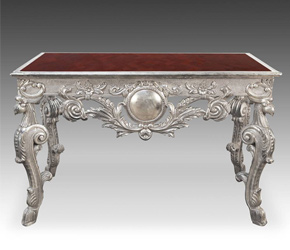 |
|
Several years ago I found myself in the home of a jute factory owner near the banks of the Hooghly River in Kolkata, India. The interior furnishings were strikingly ornate and surprisingly reminiscent of European style. A gilt console table stood near a large matching mirror. Several old school landscape paintings decorated the walls. High ceiling arches were supported by sleek white columns while a limestone staircase wound up to the second floor lined with a dark runner. Everything appeared so Victorian. It was easy to imagine ladies in tight corsets and gentlemen in tailcoats strolling down the hallways in centuries past.
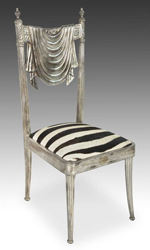 |
|
Rajasthan, India; PRIMITIVE ID# F0309-161 |
Voicing my thoughts to our host, he explained how the house was built during the British colonial period and had been carefully and faithfully preserved ever since. I soon learned that the architecture in Kolkata had been heavily influenced by colonial aesthetics, perhaps more than in any other Indian city. During dinner I asked how else European influences had affected the arts of India. Considering the question for a moment, our host then motioned to the chair I was sitting on and the table set in front of us. He touched the silver-clad arm of the chair, almost caressing it, and then he thoughtfully spoke. “This style of metalworking was a largely western concept that European trading companies brought to the country over 500 years ago,” he said. “One way it became manifest was in this elevated style of furniture.”
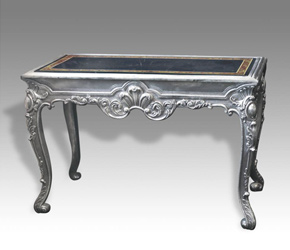 |
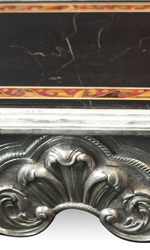 |
|
Back in those days, with the exception of royalty, most of India led a floor-level lifestyle. What little furniture existed was made purely for utilitarian purposes. The charpoy, for example, was a bed with knotted strings used in lieu of a mattress, ensuring that the recliner remained cool in India’s humid climate. Just about all other activities – for example, cooking and eating – were done on the floor. It was this culture the Portuguese, Dutch, French and British found when they arrived. As it was, finding no chairs or tables, Europeans soon brought prototypes and commissioned local craftsmen to create European-styled furniture. What they didn't expect was the level of skill and creativity the Indian artisans demonstrated as they took European furniture making to new heights. From intricate wooden carvings to inlays of stones and gems, the decorative styles the artisans created were highly impressive – especially their use of silver chasing applied to carved western style furniture.
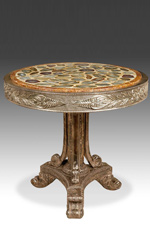 |
|
Chasing is a technique of working sheets of soft metal such as gold, silver, brass, copper and bronze by pushing the surface inward, typically over a hard surface, to create a formed design. Chasing as it applied to furniture in India could also be called cladding. Underlying the chased metal were carved designs usually rendered in teak wood, a hard wood ideal for creating durable, lasting furniture. Once the underlying furniture was clad, the metal surface could also be further “chased” by etching delicate details into the metal. This kind of metalworking has been used since antiquity to decorate masks, armor, shields, plates, goblets and sculptural art all over the world. In India, particularly during the Mughal Reign (1526-1707), thrones and state chairs were often clad with intricately worked sheets of silver and gold. Later in the 19th century, Indian princes began to commission all sorts of furniture clad in these precious metals as both silver and gold were considered pure and purifying according to sacred Hindu scripts. It’s no wonder so many thrones of rulers were clad in gold and silver.
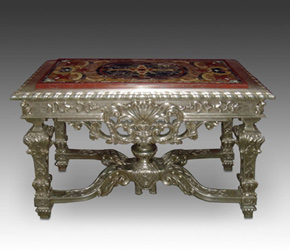 |
|
It was not just the hammered relief work of chasing or European influences that made Indian furniture of this period so special. Instead, it was the fusion of western forms with Indian artistry. This fusion resulted in all new independent styles known as Indo-Portuguese, Indo-Dutch, Anglo-Indian, or simply and more broadly as Indo-European furniture. The forms were based on western art movements such as the Italian Renaissance, Rococo and Neoclassicism, or specific styles such as Georgian, Regency and Victorian. What distinguished this furniture were their distinctly Indian designs, motifs, and decorative techniques stemming from the rich artistic culture of the country. The end product was furniture clearly elevated beyond the world of function to the world of art.
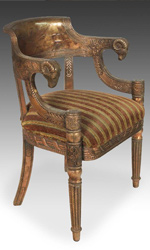 |
|
During the tumultuous period leading up to India’s independence in 1947, furniture making reverted back to a simple utilitarian nature, losing an artistic edge in favor of more accessible, less embellished styles. At that time, the tradition of cladding tables and chairs with precious metals almost became a forgotten art of the past. Even samples of chased antique colonial-era furniture in museum collections were scarce. In the late 1990s pieces in PRIMITVE's chased silver furniture collection were first commissioned. These early commissions primarily involved marrying the work of three different disciplines – carvers who made the underlying forms, silver chasers who clad those forms, and in many cases, marble in-layers who created the inlaid tops of tables in the collection. It has been said, PRIMITIVE’s modest commissions of chased furniture caused a revival in the art form, which continues to be made and appreciated to this day. No longer does chased furniture grace the halls of royalty, but instead, elegant, modern interiors.
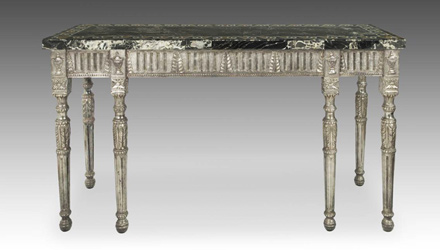 |
Download this Article: Chased in Precious Metal – Indian Silver Clad Furniture.pdf